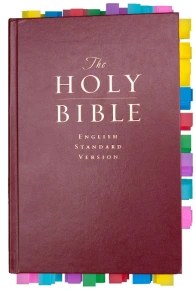2017-2018 Curriculum Plans
For my preschooler, 1st grader, and 3rd grader
Hello homeschoolin’ mamas! Its planning time here! How is your planning going? I am praying that God strengthens us with vision so that we are able to customize our family’s plans according to His perfection. To that purpose, I encourage you to print and use these visionary prayers for your homeschool. Prayer based in the authority of scripture is our foundation for success.
If you are planning “outside of the box,” you know how it takes time, but that its definitely doable, and the resulting satisfaction in the following school year makes those summer planning hours so worth it. Despite the work involved, I look forward each year to planning because of the results: seeing my kids wild about books, seeing their character being nourished, and hearing them narrate with great accuracy is the Father’s reward for this mom’s heart. God has been so good!
Simply Charlotte Mason materials and book suggestions continually capture and thrill our hearts here. As I mention below in this post, “In my experience, SCM offers living book suggestions that can not be passed up they are so good.” The readings tug on my heart all the time! SCM picks the best of the best literature available. We sometimes use book suggestions from other Charlotte Mason type curriculum suppliers for extra summertime reading, so I know some of what is out there, but I always come back home to SCM books and lesson plans for their simplicity and sweetness.
The SCM forum is my favorite place to go for school advice. Whenever I have nitty gritty education questions, I do a search on the SCM discussion forum, and find answers abounding from the ladies, who strike me as so Godly and helpful and wise. Their wisdom really stands out. The CM guidance I glean from the Simply Charlotte Mason community is a blessing, and I am sure it will especially be a great assurance while planning and teaching the highschool years.
All these things aforementioned are really wonderful, but perhaps the principle reason we LOVE doing Charlotte Mason homeschooling is because first and foremost it allows us to be together. Its hard to describe how very very blessed I feel about the “togetherness” we are growing here. Our 4 years of CM schooling have been fruitful, challenging, and thoroughly enjoyable as we learn all together. Charlotte Mason says, “the souls of all children are waiting for the call of knowledge to awaken them to delightful living.” I so agree; as my family photos here may attest, school to me is about living a deeply rich and satisfying life all together. It is our lovestory.
I have often written about the loveliness of togetherness. In my post, Soul Filling Friendship, I encouraged, “As our children mature, we will have interesting and rich conversation with friends who truly love to talk about things that matter, and who love what we love…..As we lay down our lives to nurture our children, someday the friendships we have built with them will nurture us in return. Someday we will look into the eyes of our beloved children and realize that they have become our dearest friends.” True friendship is a most wonderful result of the togetherness we are creating in our homes day by day, the process beginning when our children are still young (and admittedly sometimes hard to be with). I recall the warm feeling of togetherness growing in my heart when I wrote my post Discipling our Children at HOME sweet HOME. I gushed, “Home is where the heart is, and home is where we can best reach our children. It is our homes that give God the most undistracted access to our children’s hearts and minds. The home is a God designed dynamic learning environment for children. Therefore, we as a family commit to being at home, together, a lot, in order to build our home. We desire a slower paced environment and atmosphere in our home, where our children can soak and drink deeply of God, rather than us always rushing in and out, building up much of our lives outside of home, and separately.” Intimacy at home comes through many avenues, but I think doing school together provides families with one of the best bonding opportunities of all.
If togetherness in school is something you also desire, take a look at the SCM website and see how many subjects you can teach your whole family together, grades 1 through 12! It allows family to come together in a marvelous way! SCM is a logical choice for bigger families teaching lots of grades, and for creating a sweet sense of unity in any size family by allowing learning experiences to be shared by all. With other curriculum structured for teaching kids more separately, where different ages are reading different books in lots of subjects, natural conversations wouldn’t come up as much. For example, in a family with 5 kids there could be as many as 5 different time periods being studied for history, and so common ground is lost for conversations to occur about what is being learned. In SCM however, history might look like this: The whole family is reading Stories of America together. Oldest is also reading The Autobiography of Benjamin Franklin. Next oldest is reading A Young Patriot. Third child is reading Johnny Tremain. Finally, mom is reading aloud Benjamin Franklin by the D’Aulaires to the two youngest. Not everyone is reading all the same books, but everyone is reading about people from the same time who all were part of the events of the American Revolution. There is common ground in almost every subject to prompt lovely conversation when you teach the family together, and this is one important way that a lovely sense of family togetherness may be fostered.
I feel that the simplicity of SCM allows moms to teach from a restful place. And for moms who want the ease of a complete open and go curriculum package, SCM now offers that as an option too! There are very few curriculum packages out there that are truly CM. I personally continue to prefer to use SCM’s original do-it-yourself curriculum overview chart, which is free. Either way though, SCM is nice because you get to secure your own books, which is one, very cost effective, and two, allows you to teach to the child (and his or her needs), not to the curriculum. Almost all of our books come free from the library and are hand selected by mom.
We are looking forward to sharing another wonderful year of homeschool here with you at Jesus’ Precious Little Lambs! May God continue to draw our hearts together through the amazing opportunity of homeschool, and may He allow us to write a lovestory of togetherness as we experience the many awesome living explorations of God’s truth, beauty, and goodness.
XOXOXO Lynn
.
Now, onto the books!!! Of course some books remain the same in my plans from year to year, but I don’t want you to miss out on all the new things embedded in between, especially the Nature Study and History books planned for this year! I admit, it will be really something if you can get through all of this post! 🙂 Thanks for being patient with my gushing.
The following Annual Curriculum Plans are also available for other ages/content:
- Six and Eight are Great!
- Sweet Sixes and Sevens!
- Stupendous Fives and Sixes!
- Fabulous Fours and Fives!
- Thrilling Threes and Fours!
If what you see below in my plans looks like an impossible amount of material, remember Charlotte Mason methods use short lessons so that students can be exposed to a nice wide variety of subjects (the feast!). Here is a very doable sample schedule from Simply Charlotte Mason that shows how your week might look:
| Monday | Tuesday | Wednesday | Thursday | Friday |
|---|---|---|---|---|
| Scripture Memory (5 min.)
History (20–30 min.) Picture Study (10 min.) Foreign Language (15 min.) Literature (20–30 min.) Math/Science/Language Arts per student |
Scripture Memory (5 min.)
History (20–30 min.) Music Study (10–15 min.) Habits (10 min.) Literature (20–30 min.) Math/Science/Language Arts per student |
Scripture Memory (5 min.)
Poetry (5 min.) Geography (10 min.) Handicraft or Art (20–30 min.) Literature (20–30 min.) Math/Science/Language Arts per student |
Scripture Memory (5 min.)
Bible (20 min.) Hymn Study (5 min.) Shakespeare (20 min.) Foreign Language (15–20 min.) Literature (20–30 min.) Math/Science/Language Arts per student |
Scripture Memory (5 min.)
Bible (20 min.) Nature Study (30 min.) Habits (10 min.) Literature (20–30 min.) Math/Science/Language Arts per student |
.
_______________________________________
* * * * * * * * * * * * * * *
My Precious Students
Noah – 3rd grade Faith – 1st grade Daniel – Preschool
_______________________________________
* * * * * * * * * * * * * * *
.
Mother Study:
As I am not very familiar with academic Bible study methods, my goal in recent years became to find a good study resource so that I might learn a thing or two, or more. However, the hunt for the right resource felt like searching for a needle in a haystack. I didn’t want to do one of the many “Bible studies” I typically see with lots of contrived questions based on the popular Christian book its paired with; I wanted to learn the basic “how to” methods of timeless Bible study that can be applied to all future studies.
I never guessed that what I needed was right under my nose all the time. So happy to have found this study from my beloved mentors at Simply Charlotte Mason–no fluff, just the real stuff.
Life in the Word is a handbook for teens (or adults like me!) that walks them through various Bible studies step by step: narrative studies, word studies, topical studies, inductive studies, character studies, and more.
.
Devotions:
Personal and Family Bible reading/study, prayer, and worship
Morning Devos: Meeting with the Lord in morning devos is all about getting to know Him. Devotional time helps us to know Him for ourselves, rather than just knowing about Him. The discipline of meeting with Him everyday also helps us experience victory and stay in the Lord’s perfect will of joy and revelation and blessings. So we are careful to take our time each morning and meet with the Lord as long as we feel led. First thing in the morning we do personal devotions, then kids and mommy meet together right after for a group devo (and we also do night time devotions together as a family a few times a week). I guess we love devos.
During personal devotion time, I read my ESV Study Bible, Noah reads his Bible and then usually either he or I read The Preschoolers Bible to Daniel, who can’t read yet. Faith would sit and look at Bible story pictures for a long time before she could read, but now that she is reading, she is enjoying her (“non-twaddle”) Bible story book, The Children’s Bible Story Book by Catherine Vos. After separate reading, we worship, pray, journal, and/or read the Bible again together in order to narrate (as per our curriculum). Sometimes in the past we have used devotionals like Jesus Calling or Leading Little Ones to God or What Would Jesus Do?, but this year I think the kids will use their Study Bible (Child Training Bible) more instead, as I also work through my personal Bible study, Life in the Word, little by little each day.
Scripture Memory: We have always memorized one scripture verse or passage a month and reviewed the verses we learned during the same month in previous years. I usually picked a verse that was relevant to the character trait we were studying, I wrote the verse on our chalkboard over the kitchen table, and then we practiced it all together during breakfast. This year I would like us all to challenge ourselves with memorizing larger chunks of scripture, as well as begin to form the habit of independent scripture memorization, perhaps fitting some time for independent practice into our morning devotions routine. Just hoping to see scripture memory become somewhat more of an independent pursuit as we are growing in years. 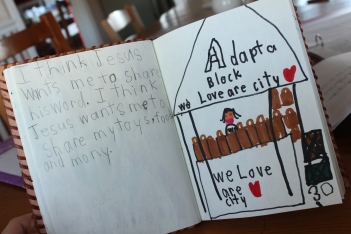
Prayer Journal: This has been a blessing! In the past we would separate into different rooms in the afternoon for a quiet time where we would spend some time prayer journaling whatever the Holy Spirit puts on our hearts. Slowly prayer journaling has been moved into our morning devotion time as quiet time seems to have phased out last year with the last of Daniel’s naps. Journaling became a time and place for the kids to specifically respond to some of the life application questions or prayer prompts posed in our devotionals as well. Maybe we will find quiet spaces in the afternoon again this year, but either way, we will continue to write our thoughts and prayers out as it brings grace to our days. The kids pages make me teary eyed they are so sweet sometimes, so I can imagine how the Lord must feel to receive His little love letters.
 Prayer Wall: Prayer Wall was a new addition this past year, and I am glad we have one now. I personally use a binder to keep track of what I am praying for, but the kids use the “Prayer Wall” to guide their prayers. The top chalkboard on our Prayer Wall lists current short term needs, and the 3 cups at the bottom contain long term prayer focuses for 1-Our Family, 2-Loved Ones, and 3-The World. For our family, since we have stood on God’s promises for various needs over the years, we now have the scriptures organized in one place (the “Family” cup) and easily accessible to the children to use in prayer. The ‘Family’ cup has slips of paper with a topic such as ‘Godly Friendships’ or ‘Health’ on one side and our corresponding promise from the Word on the other. The ‘Loved Ones’ cup has slips of paper with the names of all the family and friends our kids could think of (they sounded out and wrote the names themselves).
Prayer Wall: Prayer Wall was a new addition this past year, and I am glad we have one now. I personally use a binder to keep track of what I am praying for, but the kids use the “Prayer Wall” to guide their prayers. The top chalkboard on our Prayer Wall lists current short term needs, and the 3 cups at the bottom contain long term prayer focuses for 1-Our Family, 2-Loved Ones, and 3-The World. For our family, since we have stood on God’s promises for various needs over the years, we now have the scriptures organized in one place (the “Family” cup) and easily accessible to the children to use in prayer. The ‘Family’ cup has slips of paper with a topic such as ‘Godly Friendships’ or ‘Health’ on one side and our corresponding promise from the Word on the other. The ‘Loved Ones’ cup has slips of paper with the names of all the family and friends our kids could think of (they sounded out and wrote the names themselves).
The ‘World’ cup has slips of paper with people groups, nations, and general world needs (natural disasters, government, missions, churches, etc.). The kids can use the map on the Prayer Wall to locate the nation named on their slip of paper. We are still enjoying learning about nations and people groups from our Window on the World prayer book (usually during geography lessons), and then praying for the people using the prayer points and background information offered. Faith really loves learning about people and cultures around the world, and it was sweet to see God draw her heart to the Native American tribes this year.
Worship: The kids and I sing accapella praise and worship to the Lord every morning together. It was cute to see them become a little more independent in initiating worship this past year, and sometimes find them leading Daniel in a rousing song of Praise Ye the Lord or This is the Day. Sometimes we enjoy singing simple spontaneous Spirit-led songs unto the Lord; everyone singing their new song all at once seems to help move us out of complacent worship. Our hymn books, which are simply printed off hymns put into binders, started a couple years ago, have become a great resource of songs for us to use together in worship time or to take to a care home and minister to the elderly. The words of hymns are poignant and the message is so beautifully articulated! We did slow down last year in learning new hymns, and so we probably need to try to make a point of learning more new hymns again next year.
.
Literature:
These are some of the literature books I am thinking about buying/checking out from the library this year, but also much historical literature (not pictured), thanks our new resources All Through the Ages and the Truthquest History guides (see “History” below for descriptions).
.
Math:
Since preschool we have been using Kathy Richardson’s Developing Number Concepts math series for PreK-3rd. The more flexibly children can work with numbers and manipulate them in many various ways, the better they will be at math, and Kathy Richardson does a great job helping children to work deeply with numbers. We have been happy with this math curriculum that I found while student teaching in a elementary classroom before having my own kids. I think Noah will soon be aging out of this curriculum, so its time to start thinking about what to do next.

In the meantime Kahn Academy has helped fill in the gaps for Noah with extra math practice that he really needed, since we never seem to do many math worksheets or workbooks. Its been nice to have a practice resource to supplement our math lessons that can also be done independently, especially on full days when I don’t have time to do another lesson.
We are also excited to try out this fun living math idea to supplement Noah’s math studies this year. In Your Business he will get to pretend he is running his own pet store business! Sounds fun!

.
History:
My kids really really love history, but we have been “living” with the ancients for 3 years now, and honestly, I am eager to move up the timeline! I am excited, really excited to get into the stories of the Middle Ages and Renaissance! I am excited for my kids as well because knights and castles and kings and queens have been a major theme over the years playing at home. Now to bring it all alive!
The main goal of CM history studies is to allow the children to “live” in a time period and get to know what people and ideas were like during that era; and that goal can be accomplished through simply reading a variety of living books (spines are optional). I will explain below how we are going to greatly supplement the “living” aspect of our history studies this coming school year, while still using the wonderful living history curriculum offered by Simply Charlotte Mason as our anchor.
The Manual
In my experience, SCM offers living book suggestions that can not be passed up they are so good. For the most part, these are and have always been the living books we read together. However, next year, I also plan to begin to use two book list resources: All Through the Ages and TruthQuest, in order to pick and choose more of the best living books available for the time period we are studying (especially since we are now studying a period rich with literature compared to the ancient time period). Oh how I wish I could read all of the living books that my children will devour in their free reading time, but alas, there doesn’t seem to be enough time in a mothers day to read the day away.
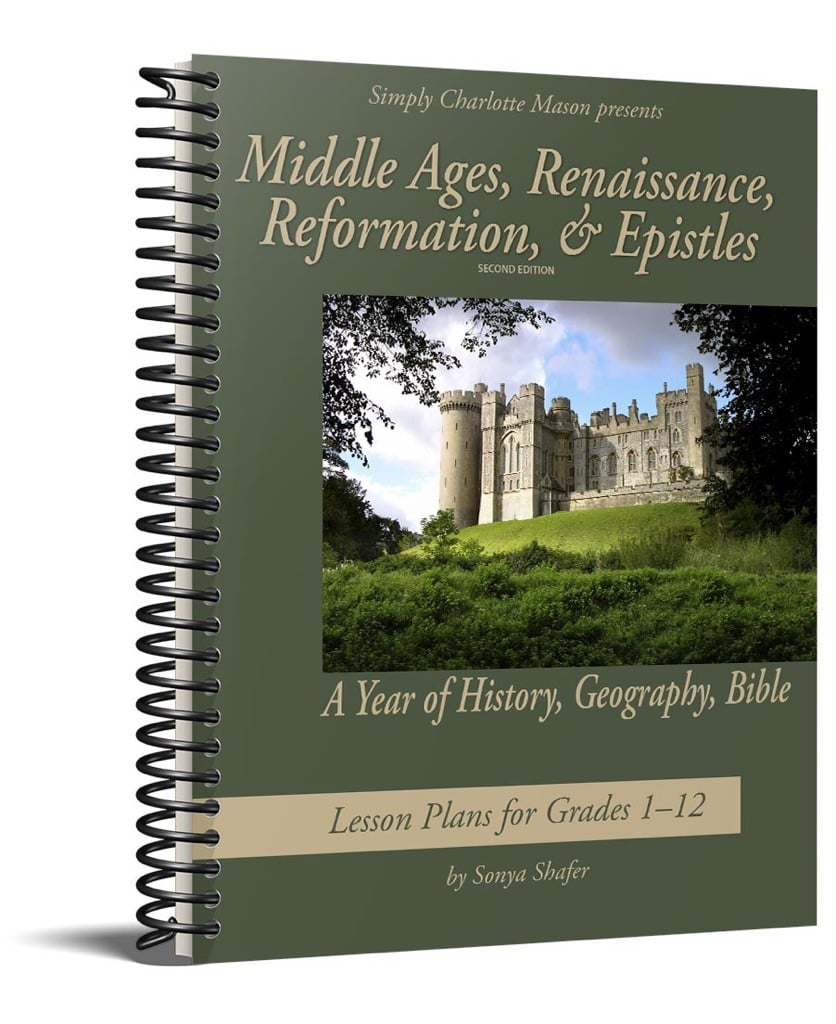
The Spines
Our SCM spine, A Castle with Many Rooms will serve as an introduction to each topic of our time period, and a springboard for further studies (through TruthQuest and All Through the Ages) into those topics. For example, I have cross referenced all the chapter topics in A Castle with Many Rooms with living books and commentary from Truthquest (below) so that each topic introduced in our spine can be fleshed out lots more through a good stack of living books.
We have slowly read and narrated the stories throughout most of the Old Testament, the Gospels, and Acts in our last 3 years of school, and learned A LOT. Next year we dive into the epistles with my ESV Study Bible as our other history spine, and I am curious to see how narration will go since the material will be theology and doctrine, rather than narrative. Thankfully, Bible this year is more than ‘read and narrate;’ the manual also includes family Bible study plans, probably to help abstract concepts in the epistles come alive in children’s minds.
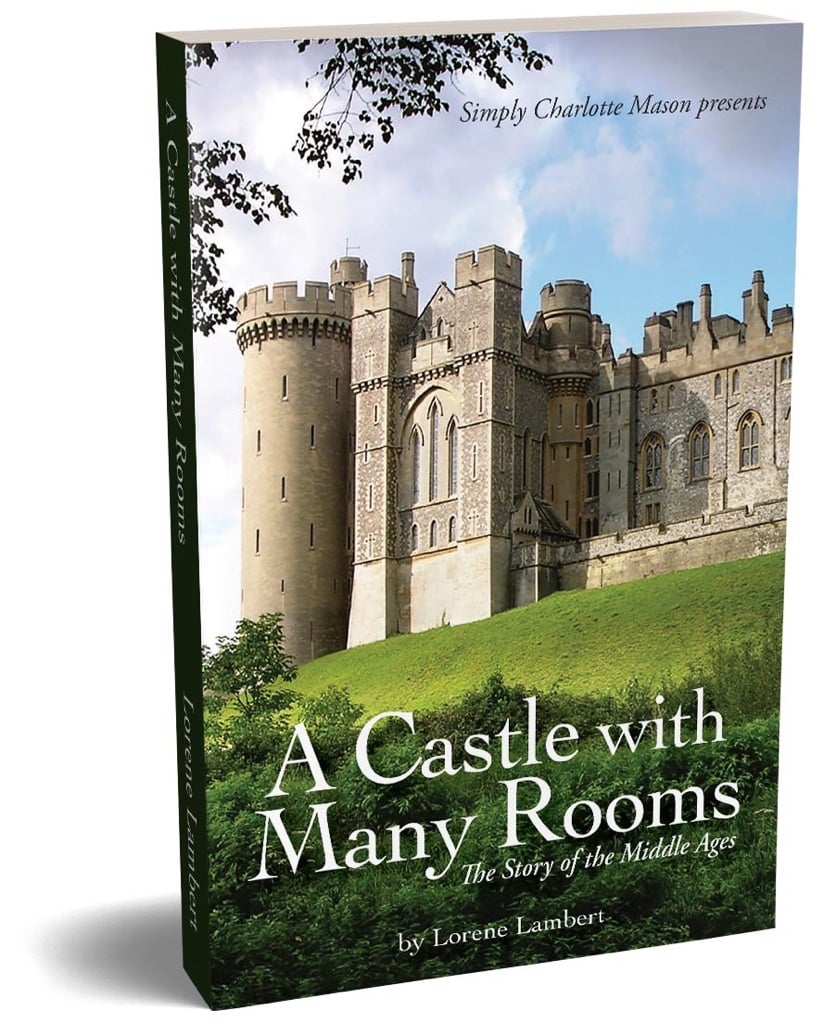

Living Books to Supplement the Spines (or use instead of):
Last year while studying the history of the Ancient Romans, I eventually found myself inwardly wearying of their corruption, violence, and pride, while I found my kids still admiring them and cheering them on, “Go Romans! I hope they win!” Did I miss something here!? These kids seem to be missing the point!! Soon enough I was sighing and rolling my eyes –outwardly– as I continued to weary with the greed and debauchery present in every history lesson. Oh dear, mom was caving. I came to the conclusion that perhaps I need to rethink how I am teaching history. My kids seemed to need some wise Godly insight into what was really happening and I seemed to need some fresh air of hope over these dismal stories of never ending evil and murder in the history of mankind.
So I started doing my homework and found TruthQuest History, a curriculum that presents a historical focus in light of God’s truth. Author of the curriculum, Michelle Miller, says, “The exploration of history, then, should reveal God and His truth, not glorify the achievements of mankind……. Let us, then, not be found teaching humanistic history. Let us learn of civilization and its beliefs in a way that reveals and glorifies the God whose name is Truth.” Yes, yes I thought. Curriculum with a strong Biblical worldview is exactly what I want!
I found out that TruthQuest History is a deep and rich literature-based history study…but with a difference. Michelle explains, “You will not learn the story of mankind; you will learn the lovestory of mankind. You will not focus on the rise and fall of human civilizations; you will focus on the arrow-straight line of God’s unchanging existence, power, love, truth, and plan for civilization. You will not simply ‘meet the culture’ or ‘get the facts;’ you will probe the truths of history so deeply that your students will be equipped to change their world!” Well amen to that!!
TruthQuest history consists of a guide for each era of history with a fantastic booklist for each topic and subtopic within that era. Also included is a thought-provoking introduction for each topic, written in a lively conversational style, in order to provide context background that kindles interest (and promotes strong Biblical worldview). A unique aspect of TQH is a primary focus on the central questions of life: Who is God, and who is man in relation to God? If we want children whose minds are awake and alive to the most vital issues of life (which is what philosophy is about), then TruthQuest History is an outstanding choice. I love how the author says, ‘You won’t need any tests to show that your kids are learning: they’ll be living what they learn, playing what they learn, talking what they learn, and praying what they learn!’ Ok, that’s definitely what I desire for my kids!
All Through the Ages is another even bigger book list of living books. I couldn’t help myself; I have wanted it for years, so I bought it too. With 7,000 books listed from every historical era and every reading level, all you need is a library card (using the interlibrary loan system is very helpful too for securing those hard to find rare gems, which ATTA is full of). All the research is done for you and the books are selections you can trust. ATTA is a such a worthwhile purchase for any homeschool; its comprehensive coverage provides families with the ability to spread a feast for their children’s minds and hearts for all 12 grades. I won’t have to hear my kids say, “I have nothing to read!” again, especially now that I finally know about the interlibrary loan system (can’t believe I just recently found out about it!). ATTA also includes suggestions for living geography and science books. Its a great buy for anyone willing to make good use of their library!


.
Geography:
Forming a heart for the people we are studying, and have studied, by praying for them, is the most wonderful and important aspect of a child’s geography study. When we found the book Window on the World by Operation World, with its cultural information, photos, and prayer points for countries around the world, I felt like we found the critical component that had been missing in our homeschool studies. The book is designed to help kids get started in praying for the world, but it has certainly served to soften my own calloused grown up heart. One day a week, on geography day, I send one of my kids to randomly pick a slip from the Prayer Wall’s ‘World’ cup. We read about that selected nation or people group in Window to the World, and then we each take a turn to pray over them before we dive into our geography lessons.
Since history next year covers early exploration in the Americas, our geography curriculum coincides by taking us on visits to South America and Central America. Visits to South America and Central America includes map drill, making your own maps, and living books. We regularly “visit” families homes from various countries to see how they eat and how they live in the fascinating books Hungry Planet and Material World, our geography “spines.” We love geography day because it feels so personal.
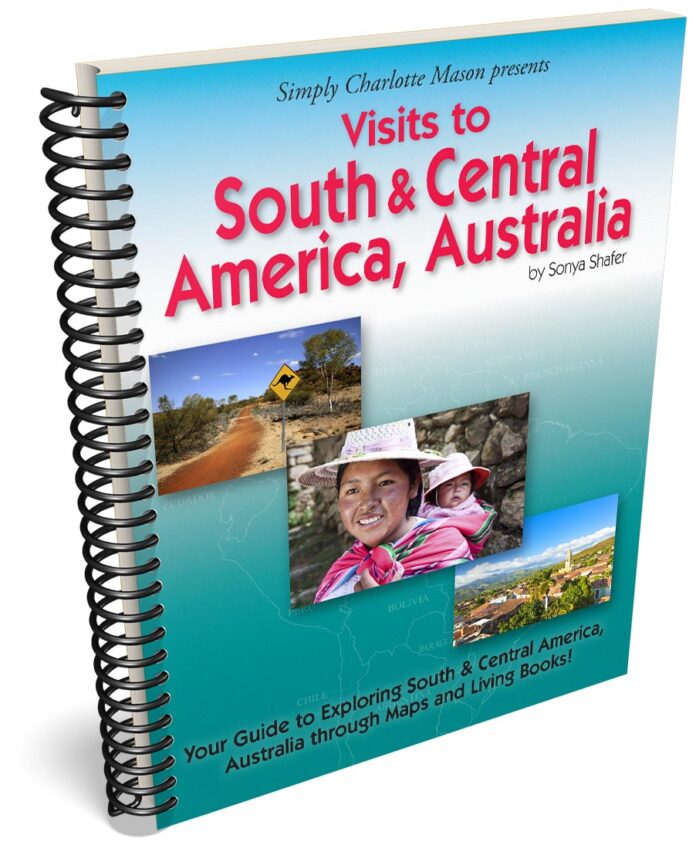


.
Character Study:
Lots of missionary books this year. The Millers Series is incredible!!!
YWAM Heroes books about missionaries are wonderful.



.
Habit Training:
Almost every book we read is selected with the purpose of shaping and developing our hearts and minds, and so thankfully, much of our kids character development happens proactively, without much direct or explicit teaching necessary. In this way, there is lots and lots of habit training occurring everyday. However, habit training sometimes requires a reactive approach as well, better known as discipline. For our our bigger discipline needs we use the Child Training Bible, which helps children do topical Bible studies on things like anger, pride, or complaining. After studying all the verses marked on a topic, my kids choose one verse to handwrite out and hide away in their hearts so that they might have strength against future temptations. (We also plan to use the Child Training Bible for Bible study purposes, as mentioned above in “Devotions.”)

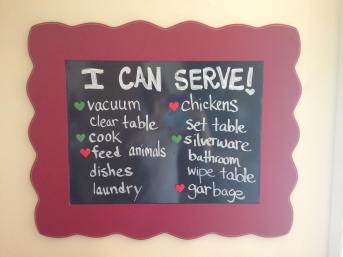
Our Service board show kids what their daily assignments are. Noah is the green markers and Faith is the red markers (clay shaped into hearts).
We will continue to use our Stewardship Street coin banks to hold earnings for Service Opportunities done at home (better known as chores). The kids are taking over the work around here little by little, and I am working myself out of a job; its great! Ok, it is lots of hard work staying on top of them, but I do think it is getting better with time. The life skills and the character that work helps develop in children is so important, so we keep at it.
We will continue to use the following excellent resources for habit training and character study: 
Nature Study:
As the foundation of our nature study, we pray– that God will open our eyes, ears, and hearts to more fully see all the special things of His creation…. and He really does! This past spring and summer we fed 3 caterpillars at home, hatched baby praying mantis’ and raised one almost to adulthood, cared for a backyard lizard and a backyard frog in our terrarium, and caught and observed butterflies. A terrarium has proved to be quite helpful for nature study here. 🙂 And canning jars with some mesh or tulle on top too.
I was so happy to see Faith’s excitement over critters really reach an all time high this year! She ran around with her butterfly net catching all kinds of things as her gross motor skills caught up with her butterfly catching dreams in kindergarten. She was the one filling our terrarium this year with all of her special live critter finds. I have been waiting and waiting to see this kind of nature enthusiasm to emerge in my kiddos. Praise God!!
We have always enjoyed going out to hike, play, and observe the flora and fauna in various parks when the weather is nice. This past year we surpassed our previous comfort zone and actually got out hiking in the rain and were rewarded and wowed with sights we had never seen before, such as beautiful ephemeral waterfalls. Often we bring specimens home to draw, but I love sketching out in nature whenever possible. It is hard work with three young children and a backpack of supplies in tow, but once settled, nature journaling can be the quietest, most peaceful moments of homeschool; moments that nourish my soul like nothing else. I remember one day last year at the nature park with my children, we sketched together in sweet (voluntary) silence for at least half an hour–it was surreal. I look forward to more of that!
I am super super excited about an amaaaaazing nature study resource I just bought, The Laws Guide to Nature Drawing and Journaling. It teaches anyone how to observe nature and journal his experiences, plus it includes lots of art instruction–just the kind I have been looking for. John Laws also offers free nature journaling classes at some of the local libraries in the area.

.
Handwriting:
First off Noah needs to finish up his second round of Print to Cursive this year (he is doing the book twice because he needs more practice). Hopefully by mid-year, or before, he will get into his next cursive book, Hymns in Prose. Faith will continue practicing printing and begin cursive in her first round of Print to Cursive.
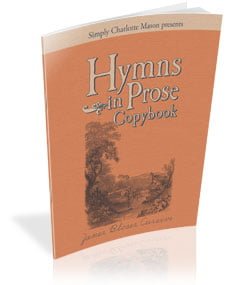
And little Daniel will start to practice his letters on our little black chalkboards from Handwriting without Tears, just like Noah and Faith did once upon a time.
Here is a flashback!
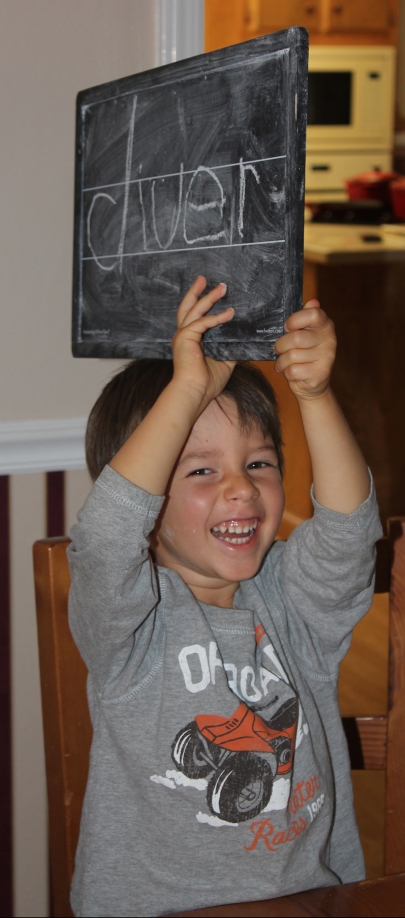
.
Spelling:
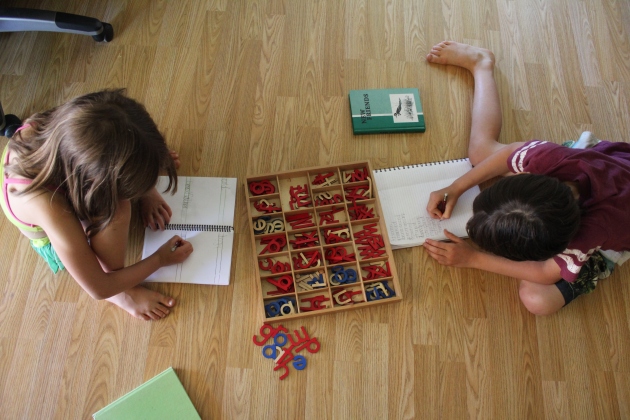
My 6-8 year old students spell words using a Montessori alphabet

My preschoolers word build using Lauri’s A-Z puzzle
We have used a unique but effective spelling method with little students 8 and under for a number of years now. I explain our methods step by step in this post (scroll down down down).
Following in Faith and Noah’s footsteps, little Daniel will begin using our Lauri alphabet puzzle to sound out and word build his first three letter words this coming school year!
“The gift of spelling depends upon the power the eye possesses to ‘take’ (in a photographic sense) a detailed picture of a word; and this is a power and habit, which must be cultivated in children from the first.” –Charlotte Mason

As much as we have loved our self contrived spelling methods, we are excited to move our 3rd grader Noah up into prepared dictation using classic literature selections in the curriculum Spelling Wisdom. As Charlotte Mason students typically delay formal spelling instruction until the 3rd or 4th grade, next year will be the first “official” year of spelling instruction for Noah, and I think he has been well prepared for Miss Mason’s simple method of prepared dictation. He and I are looking forward to it!
Noah will also begin simple 10 minute language lessons next school year. Using Language Well pairs with Spelling Wisdom and teaches English usage, punctuation, capitalization, grammar, and composition through great literature. And just for fun, we will try using Story Starters to have the kids write creative stories, which they love to do (the story crafting more than the writing). 🙂
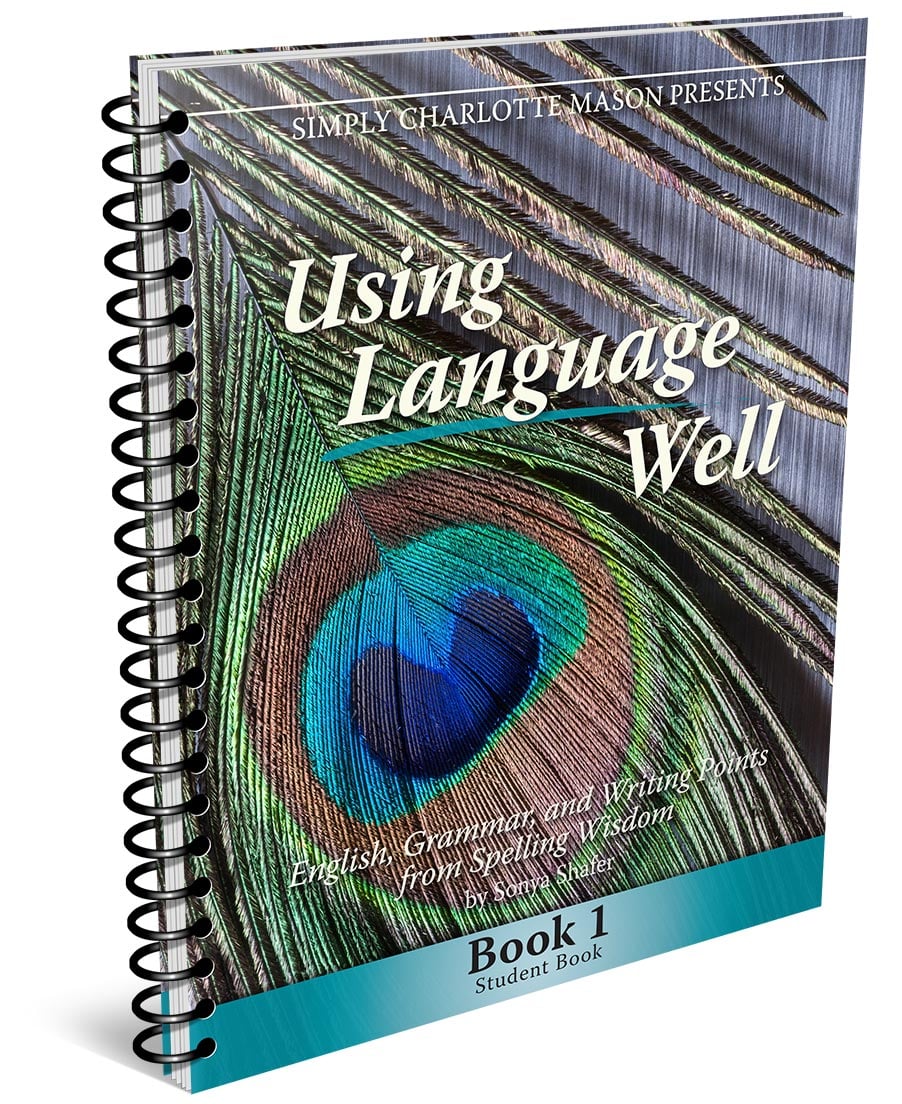

.
Vocabulary:

Produced during the years when the American home, church and school were established upon a Biblical and patriotic basis. The American Dictionary of the English Language is based upon God’s written word, for Noah Webster used the Bible as the foundation for his definitions. Scripture verses are referenced throughout.
For vocabulary studies, I continually attempt to explain vocabulary words off the top of my head the moment we approach them in our readings, or use my phone to look words up super fast so we can quickly move on with better understanding of the material. Sometimes I highlight a few key words while reading that Noah can choose to define later. Noah looks up one word, any word of choice, once a week in Noah Websters 1828 Dictionary and writes out the definition in his vocabulary notebook. Next year Faith will join him in our old fashioned, but worthwhile, dictionary skills lessons. It should prove to be interesting! 😉
.
Reading:
So thankful that I have two growing readers in our school. We reeeeally love our Pathway Series Readers, that are so full of wonderful character lessons. My kids are the ones who actually initiate reading lessons here by coming up and asking if they can read to me all the time because they enjoy the stories that much. All the stories center around an Amish family’s farm life. Children are expected to obey their parents, respect their teachers, ask forgiveness when they do wrong, and humbly submit to the discipline of those in authority! Yet they still enjoy life!! There are Pathway readers available up through an 8th grade reading level.
Noah uses the readers mostly for practicing good prosody; Faith uses them for reading practice. The readers have also provided spelling words for my younger kids (preparing them to switch to prepared dictation in 3rd grade). I explain the effective spelling method we have used for a number of years in this post -scroll down.

.
Art Projects:

Faithy’s Penguin Project from Preschool
I love kids art. Noah and Faith’s bedroom wall is covered in a growing menagerie of their beautiful artwork. This school year we will continue to do free art, directed art, and picture book inspired art as always. We do perhaps 2-6 “frameable” projects a year. Other areas of school such as nature journals, prayer journals, history/Bible narration drawings provide us with regular drawing practice as well.

Every once in while we use these worksheets with simple drawing tutorials for kids. These painting lessons could give me ideas simple enough to do with Daniel (4years). However, I have yet to find the kind of art lessons I am really desiring for the kids and myself, never the less, we seem to be doing fine and learning anyway. Plus, as I mentioned in “Nature Study” above, John Law’s book has great art instruction that I think is going to be super helpful to us across the disciplines.
.
Art Appreciation, Music, and Poetry:
A Charlotte Mason school includes Picture Study, Classical Music Study, and Poetry Study. Simple exposure to the humanities is what Charlotte Mason said to give our children’s eyes and ears opportunity to learn beauty.
“We all have need to be trained to see and to have our eyes opened before we can take in the joy that is meant for us in this beautiful life.” -CM
For Picture Study, we found that having an actual book in front of us was a lot easier than doing picture study on the computer. We look for coffee table type books with large paintings so everyone can see (we will also find art books through All Through the Ages, and TruthQuest). Picture study will hopefully include several artists and composers this year as there are a plethora of choices in the Middle Ages and Renaissance. To begin with, Picture Study for us was simply talking about what we saw while we all looked at a piece of artwork during breakfast. Lately however, we study the picture, then I hide it, and we take turns listing all the descriptive details we can think of (with the intent of finding things others didn’t notice). Its fun to try and stump each other. Everyone is eager to see the picture again in order to find what he or she didn’t notice the first time. This basically is Charlotte Mason’s simple method of picture study.
A list of possible artists to study:
- Giotto-1266-1337
- Botticelli-1444-1510
- Da Vinci- 1452-1519
- Michelangelo- 1475-1564
- Albrecht Durer- 1471-1528
- Raphael- 1483-1520
- Pieter Bruegal-1525-1569
- El Greco- 1541-1614
- Diego Velazquez-1599-1660
- Rembrandt-1606-1669
- Johannes Vermeer-1632-1675

I hear Opal Wheeler writes great biographies on composers (and a few artists) for kids, so I would like to try Giotto Tended the Sheep.
.
For Music Study, here are a few ideas from charlottemasonhelp.com for teaching young kids about orchestra, ballet, plays, opera…….and for exposing them to Medieval music.


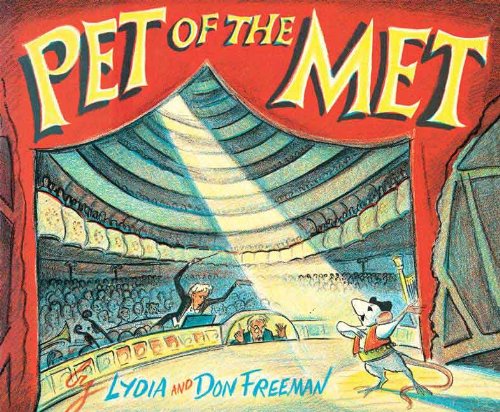

.
For Poetry Study, we will continue to memorize one poem a month to practice recitation, try to read others from the following books, and attempt to write our own poem every once in awhile just for fun. You never know, poetry can sometimes turn out better than you think it will. Noah’s Mother’s Day poem to me was a surprising delight last year.

Handicrafts/Life Skills:
My “Activity Brainstorm Page“, listed on my homepage menu has lots of crafty ideas. The craft projects include holiday, seasonal, and themed ideas which are an ongoing collection of various ideas collected from the internet. We purposely save art projects, craft projects, and fieldtrips for “Fun Fridays,” our light day of school. I would love to get scrapbooking and put all the family history info we gathered this past year into a keepsake book. We will also continue to try our hand at embroidery (a nice activity during read alouds) this next year since we took some baby steps towards learning it this past year.
Here is a plethora of life skill ideas as well.

.
Spanish:
After two years of failed attempts at learning Spanish, it was wonderful to sign up for Spanish class with our native speaking friend Miss Maria and let her do the teaching. We were the only ones in the class, so we got a lot of personal attention. I am happy to say that we finally really enjoyed Spanish this year. We still haven’t watched these crazy silly Spanish videos for kids by Salsa, so I will leave it on the plans.






